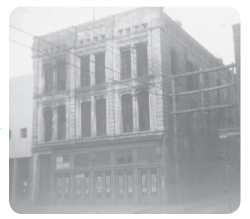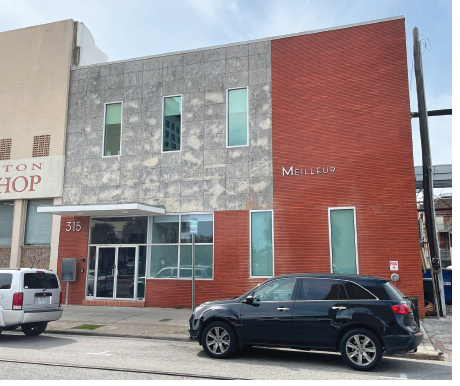During the Great Depression, a lucky few Galvestonians called the Marble Palace home. Not literally a palace, the hotel at 315 ½ Tremont was owned by Jack Diamond (1875-1947) whose intention was to provide support and housing for men who were willing to earn their own spot in the American dream.
In 1931, Diamond wrote a spirited letter to the local newspaper clarifying his mission. He stated that the rooms at the inn were not free simply because he wanted to help those who would make an effort to work.
He and his wife Flora (1909-1981), the daughter of World Heavyweight Boxing Champion “Gentleman Jim” Corbett, provided a clean, safe place to live for those whose goal was to improve their lives.
Rooms could be rented for 35 to 50 cents, or a bed in a dormitory could be had for 25 cents. Each person was given their own clothing locker, coffee and buns each morning, soup and bread at night, soap to wash clothes, use of a large drying room, razors and shaving necessities, shoe polish and brushes, writing paper, envelopes, stamps, and electric irons to press clothes.
Showers and tubs, with hot and cold running water, were also available in the shared bathrooms. All these necessities would help keep the residents comfortable and presentable while looking for employment—a gift to those who found themselves down on their luck during a difficult time in American history.
Diamond, an immigrant from Scotland, had once been in financial straits himself, and sympathized the situation was not always something one could control.
Diamond, who at one time lived in the three-room manager’s apartment of the hotel with his wife and children, also operated the Texas Hotel on the northeast corner of 25th and Mechanic, the Royal Hotel at 22nd and Church, as well as a soup kitchen on the southeast corner of 26th and Mechanic. The Royal Hotel was operated as a shelter, exclusively for women and children, for several years.
Each of the hotels served meals to anyone who needed one, regardless of where they lived. A number of local businessmen provided financial support to the kitchens, including Joseph J. Kane and George Sealy.
On Christmas Day 1933, approximately 500 jobless seamen, fishermen, and single homeless men were served a full dinner with all of the festive trimmings at the Marble Palace, in cooperation with the Salvation Army. Funds for the dinner were provided by the government through the transient bureau.
 Not content with these undertakings, the upstairs of his tavern Jack’s Place at 2401 Strand operated as the Galveston Christian Home with the help of the Salvation Army.
Not content with these undertakings, the upstairs of his tavern Jack’s Place at 2401 Strand operated as the Galveston Christian Home with the help of the Salvation Army.
But the Marble Palace was the Diamond couple’s pride and joy. A folder in the collections of the Galveston Texas History Center is filled with numerous letters of praise for the cleanliness and manner of operation of this project. Diamond liked to refer to it as a “working man’s hotel.”
The building, which was erected in 1883, had been repaired after the Storm of 1900 and again in 1919, providing a sound space for the hotel. A furniture store occupied the ground floor of the Marble Palace. The second and third floors included the family’s apartment space in addition to 23 bedrooms with seven-foot-high partitions, and a dormitory with 25 beds.
The 1940 census lists the Diamond family living at the Marble Palace with men from Louisiana, Texas, Michigan, Oklahoma, Missouri, Germany, and England. Their professions included painter, merchant marines, grocery clerk, hospital orderly, and laborers ranging in age from 32 to 60. The number of men who passed through the doors of the hotel for safe lodging during its years of operation are inestimable.
 Speaking about his former guests, Diamond related that many who came in strained circumstances soon had “their wives and families in our midst and fully appreciate what has been done for them in the line of finding employment, also carrying them over until their first pay day. From that point, they were invariably able to take care of themselves and make good here. When they make good by finding employment, they invariably send for mother, father, sister, or brothers, then rent a home of their own, with a good word for the city wherever they go.”
Speaking about his former guests, Diamond related that many who came in strained circumstances soon had “their wives and families in our midst and fully appreciate what has been done for them in the line of finding employment, also carrying them over until their first pay day. From that point, they were invariably able to take care of themselves and make good here. When they make good by finding employment, they invariably send for mother, father, sister, or brothers, then rent a home of their own, with a good word for the city wherever they go.”
There were rules, of course. Each man had to display a sincere attempt at finding a job to become self-sufficient, and there was no bootleg whiskey, abusive language, or laziness allowed.
When Jack and Flora Diamond retired in 1942, the Marble Palace was sold and the name changed to the Rio Hotel. The couple moved to Bolivar Peninsula, where Jack died in 1947, and Flora passed away in 1981.
Tragedy struck in June 1957, when the hotel suffered one of the largest downtown fires in years, killing two of its residents. The blaze broke out about 11:30 a.m., just after witnesses in the area reported being jarred by an explosion.
Ten fire companies rushed to the scene shortly after the alarm sounded. Firemen worked diligently to prevent the fire from spreading, as an estimated 1,000 onlookers watched in shock. Within an hour after their arrival on the scene, the conflagration was under control, with only minor smoke and water damage done to nearby buildings.
The victims of the fire were identified as Josie Hale, a 57-year-old widow, and 71-year-old William Dabney who had been crippled after breaking his hip.
Henry Wooldridge, who had assumed management of the hotel only a few days before the incident, suffered a heart attack as he surveyed the damage in the company of police and fireman later that day. He told officials, before he passed out, that he had attempted to drag Hale from the burning building, but she broke from his grasp and plunged into her fire and smoke-filled room in an attempt to save her small 12-year-old dog.
“Mrs. Hale didn’t smoke,” Woodridge related, “but twice a day, faithfully, she would go to her room and light candles to pray.” It was his assumption that those candles were the origin of the fire.
The solitary good news resulting from the incident was that a third person who was thought to be lost in the fire, a dishwasher at a local restaurant, turned up safe later that night after his shift at work.
Only a shell of the building and the frames of beds and other furniture, visible through the windows, were left after the inferno was extinguished. The Rio Hotel sign painted on the front of the building had burned off, leaving the original Marble Palace logo showing through like a ghost from the past.
The third floor was removed from the building in August 1958, and the lower portion was rebuilt, elevating the first floor. No feature of its exterior today would hint at its colorful past.
In 1982, Galveston City Council approved Jack Diamond Jr.’s request to place a marker in front of the site of the Marble Palace, beside the Galveston Bookshop, to honor the memory of his parents and what they accomplished for the less fortunate members of the community.
His petitions for the plaque included more than 1,000 signatures from citizens, many of whom remembered the Marble Palace, The Texas and Royal Hotels. At the time of the unveiling, the building was home to the Galveston Chamber of Commerce, and Diamond commented that part of the old hotel stairwell still stood to the south of the offices.
“With the help of friends who donated money,” the younger Diamond shared, “my parents were able to buy more food and make life a little easier for people.”